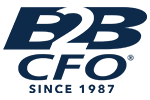
8 Strategies to Weather Inflationary Times in Your Business
Posted on July 8, 2022 by Peggy Head
You don’t have to turn the news on twice to know we are currently on a road of high prices, supply chain reduction and a tight labor market. “Prices rose 7.5% in January compared to the year prior, according to the most recent Consumer Price Index (CPI) report,” Forbes reported just last month. “This is the biggest annualized growth in CPI inflation since February 1982…[and] core CPI rose by 0.6% in January, and climbed by 6.0% over the last 12 months, the largest gain since August 1982.” As it is, with gas prices increasing, workers leaving their companies and getting stung by supply chain challenges, businesses can still take action to bolster their financial health. Working with a B2B CFO®, you can weather this inflation surge and set your company up for success in the new normal of costs. To help, we’ve assembled eight steps business leaders can implement right away.
1. Meet Inflation Head to Head
As inflation goes up, so will the price of what you are selling. In 2021 alone, “almost two in every three small businesses (63%) have had to increase the price of their products and services.” This is a crucial step to make sure you are not falling behind even more in your revenue. For businesses that must raise prices to cover costs, the most common approach is a blanket increase. However, particularly for those with price-sensitive customers or stiff competition, there are creative pricing strategies that companies can incorporate to lessen the perceived impact of an increase. Examples include product bundling and unbundling, installments, adding or removing features, or different pricing models for different product varieties. Work with a B2B CFO® to see which products and services you offer provide the greatest value to your customer-base and how to strategically increase prices.
2. Cash In to Help Cash Out
When it comes to inflation, purchasing power goes down as costs go up—rendering cash a critical factor. Building up your cash reserves, moving cash to other accounts like interest-bearing certificates of deposit, savings accounts or money market accounts or even bond funds if you have them. Cash reserves and saving cash will give you the time you need to slowly raise the prices of your goods or products and can protect you against short term issues such as a drop in sales or an unexpected expense.
3. Evaluating Your Expenses
When it’s time to be saving every buck you have, looking at what you’ve been spending them on is critically important. Take some time to understand what your operating costs and your labor expenses have been. What departments are costing the most and why? What products take the most time to make and deliver and what are your most profitable products? Are product prices keeping pace with rising costs? Are there opportunities to improve products, pricing or terms with existing suppliers? Are there new supplier relationships to explore that may improve profitability? Cost reductions in and of themselves automatically increase profit in the short term. However, they may still not be the best decision because they may undermine the company’s ability to continue generating quality revenue. Consider strategically what expenses can be reduced that won’t jeopardize quality and customer satisfaction.
4. Make the Most of Business Loans
Just a few months ago, FORTUNE released a feature sharing “45% of small businesses say they have dealt with inflation by taking out a loan over the past year.” They went on to share that “last year the average small-business loan was $71,000 while the average Paycheck Protection Program loan issued in 2021 was $46,000, according to the Small Business Administration.” Many business owners do seek financing to deal with the impact inflation has on operational costs. Before you decide to borrow money, however, it’s important to examine whether doing so is the right approach for your company. If you do decide to borrow money for your business, it’s important to take the time to shop around and consider several financing options.
5. Taking a Second Look at Investments
As a business owner, you just may already have a small to extensive investment portfolio you’ve been building over the years. If inflationary pressures are causing financial strain, it might be best to work with a trusted investment advisor to liquidate some of the investments that aren’t generating income now. Schedule time with your investment advisor to review your portfolio and discuss changes that would improve quality of earnings in an environment of rising inflation.
6. Emphasizing Efficiency
Increase attention to every dollar spent on resources in your organization. Are all of those dollars returning maximum value to your business? Assess how much work is getting done, by who, on what and how. Are team members positioned for optimal productivity? Can you achieve productivity gains by changing processes? Examine outsourced services such as advertising, technology support and others. Perhaps the existing terms and scope of work can be revised and updated to better serve your needs now. Skills shortages, higher salary and benefit costs are affecting businesses now. Increasing automation can free up workers to focus on strategic value-added activities, benefitting the business and increasing retention.
7. Thank Your Employees
When inflation is on the rise, it’s the time to do everything possible to reinforce positive employee relationships. 69% of employees say they would work harder if they felt more appreciated.4 A word of thanks or simple expression of appreciation to employees for their contribution to the company’s success goes a long way. Review your current employee policies and consider opportunities to add flexibility that will communicate to team members how highly you value them. Perform a culture-check of your organization and implement changes designed to improve your employee engagement levels. Many of these ideas and changes are low-cost ways to increase employee satisfaction, productivity and retention.
8. Work With a B2B CFO®
CFOs are the very trusted financial advisors you need during times that continue to be unprecedented and out of our control. With markets finding outside forces like the pandemic and current news playing a huge role in purchasing power, it’s best to take the time and find who can help your company raise revenue and grow profits even when there are barriers along the way.
Sources: 1Forbes. Why Is Inflation So High? February 10, 2022 US Chamber of Commerce. Small Business Index Q4 2021. January 2021. 3FORTUNE. Almost half of small-business owners are taking out loans because of inflation. December 2021. 4Get VOIP, 50 Employee Engagement Statistics You Need for 2022 October 15, 2021

